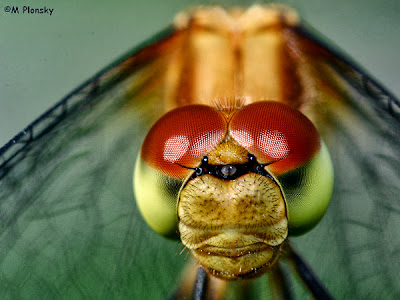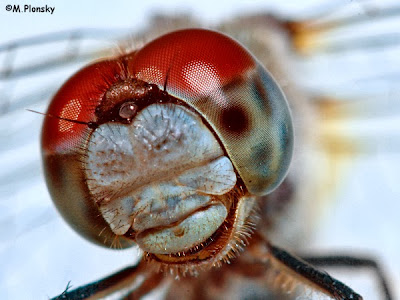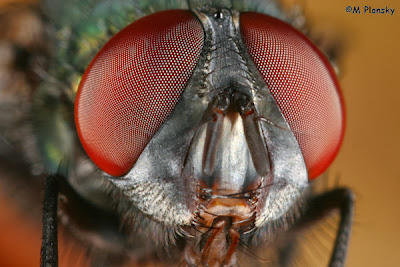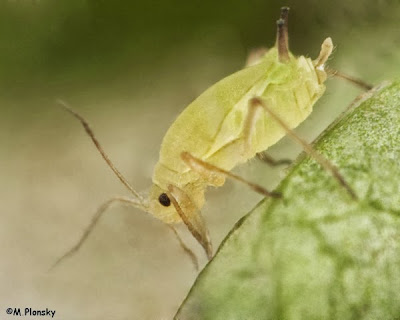My day job is a professor. I became interested in imaging in 1989 when I began using a computer/projector to present my lectures. I started scanning images and learned my way around the digital darkroom. I took an interest in photography in 2001. I began with point and shoot style cameras (with various attachments) and when my images started to earn income; I was able to purchase better equipment. Thus, I was weaned on digital photography. The immediate feedback the digital camera provides was a key factor in my rapid learning curve. I specialize in macro photography.
 |
| The Argument - Ant and Ladybug arguing over an aphid.Taken with a Canon Digital Rebel, Tamron 2xTC, & Canon 100 mm macro. |
One of the reasons I enjoy macro photography is because it allows you to see what you ordinarily cannot. When creating an image, my goal is to have the viewers jaw drop in awe when they view it. High magnification macro (or what I call “extreme macro”), when done well, tends to cause this reaction in the viewer (as well as in me). It is one of the reasons I enjoy it so much.
 |
| 12 Spot Skimmer Dragonfly Taken with a Canon 20D, Tamron 2xTC, & Sigma 180 mm macro. |
Macro photography is typically defined by the fact that the image obtained on the film plane is close in size to the subject. In simpler terms, macro photography is when you take the image at about life-size. Thus, a true macro lens will allow you to focus up to 1:1 or 1x (i.e., life-size). Macro lenses differ in their focal lengths and this influences the “working distance” (or the minimal distance the lens has to be from the subject or order to take a picture that is in focus). Longer focal length lenses give you more working distance. This can be helpful with live subjects, but makes it harder to shoot without a tripod.
 |
| Fly Taken with a Canon 20D, Tamron 2xTC, & Sigma 180 mm macro. |
Although most macro lenses only go to 1:1, there is a variety of ways to get behind this limitation of magnification. I will briefly list and discuss these below.
1. Specialized macro lenses
Canon makes a lens called the MPE-65mm. This manual focus lens enables 1-5x magnification. The working distance is about 4 inches at 1x and only an inch or so at 5x. While this is a dream lens for extreme macro photography, the small working distances are a disadvantage. This is especially the case when photographing live subjects. I am not aware of other manufacturers that have such a lens available.
2. Diopters or closeup lenses
These screw on to the front of the lens and allow the camera to focus closer than it normally would be able to. It is like reading glasses for the camera. A disadvantage of their use is the loss of infinity focus. An advantage is that they are very portable and are easily attached and removed.
3. Extension tubes
They are literally hollow tubes that fit in between the camera and lens. They come in various sizes and can be stacked. They allow the lens to focus closer than it normally would. A disadvantage of their use is the loss of infinity focus. An advantage of their use is the fact that they do not add any glass, which has the potential to degrade the image. A variation on the extension tube them is a clumsy apparatus called a “bellows”.
4. Teleconverters
Teleconverters (TCs) also fit in between the camera and lens. They are special lenses that multiply the focal length of the lens. They have an interesting effect on a macro lens. For example, consider a 2xTC. It would enable a macro lens that does 1x magnification the ability to do 2x at the same working distance or 1x at twice the working distance. An advantage is that you retain infinity focus. Some folks argue a disadvantage of TCs is that they degrade the image. While I tend to agree with this argument in other areas of photography, it seems to be much less of a problem with macro photography. Perhaps this is because macro lenses are designed to be sharp throughout the lens rather than just in the middle.
5. Reversing a relatively short focal length lens on another lens
Theoretically, if you reverse a 50mm lens on a 100mm lens, you would get about 2x life-size. Reversing rings (or macro couplers) are available to make this easy. The advantage is you probably have all you need except for the macro coupler which costs less than $10. A disadvantage is that the working distance is only an inch or two and the rig is typically heavy.
6. Reversing a short focal length lens on the camera itself
This can work well but is probably the most difficult to do. Adapters are available to make the attachment easy. A problem is lighting. You need to open the lens wide to focus, but stop it down to take the picture. Also, the exposure is done manually. I should note that Novaflex makes a special apparatus to make this easier.
7. Various combinations of the above
I am curious fellow and seem to enjoy tinkering a bit, so I have tried all kinds of combinations and permutations of the above. Of relevance to this article, is that if you are going to use extension tubes along with a TC, you will get more magnification by putting the tubes between the TC and lens rather than between the camera and TC.
I chose to focus on the use of TCs in this article because a lot of folks have them already and do not realize how useful they can be in macro photography. Although I shoot with mostly Canon equipment, what I speak of applies to any dSLR that has macro lenses and TCs available for its mount (which most do). In fact, I even used a TC for macro photography when I had a point and shoot style camera. In this case, I attached a diopter (or two) to the lens (using a third party adapter) and then attached the TC (which was designed for point and shoot cameras) after the diopter(s).
 |
| Meadowhawk Dragonfly Taken with a Canon Digital Rebel, Tamron 2xTC, & Canon 100 mm macro. |
An important issue to keep in mind is that TCs reduce the amount of light reaching the film plane. In other words, they make the aperture smaller (and thus result in a larger F value). The aperture needs to be multiplied by the power of the TC. Some lenses/camera combinations (what I call “optical marriages”) realize this and do it automatically, while others do not. You can tell if the optical marriage is giving the correct reading for the F value with the following procedure. Let’s say you have a 100mm F2.8 macro lens. If you attach a TC, and the lens still tells you that you can shoot at F2.8, it is not taking the TC into account. My macro lenses do not take the TC into account. Thus, in general, I shoot macro with F16. If I am using a 2xTC, I have to set the camera to F8 in order to shoot at F16 (2 x 8 = 16).
 |
| Garter Snake Taken with a Canon 20D, Kenko 3xTC, & Canon 100 mm macro. |
I should also note that while some optical marriages work, others do not. For example, I was able to shoot fine with a Canon 20D, Kenko 3xTC, and Canon 100mm macro. However, this setup does not work with my Canon 40D. Trial and error is necessary to determine which optical marriages work. Sometimes taping some pins on the lens or TC can get the marriage to work. Sometimes a small extension tubes placed in the right place can make the difference as well.
 |
| Another Meadowhawk Dragonfly Taken with a Canon 20D, Kenko 3xTC, & Canon 100 mm macro. |
When I was preparing this article, a lazy ladybug appeared on my desk, so I put it on a white piece of matte paper and used it as a subject for all of the images. At the very bottom of this article is a table demonstrating what the ladybug looks like with various TC/lens combinations. Click on the small image for the full size version. I describe the equipment and techniques used for taking the images below.
Concerning equipment, I used a Canon 40D camera and a Canon MT-24EX flash (the flash heads were covered with Omnibounce diffusers). The lenses used where the Sigma 50mm macro, the Canon 100mm macro, the Sigma 180mm macro, and the Canon 65mm macro. The teleconverters used where the Kenko 1.4x, the Tamron 2x, and the Kenko 3x. As I noted above, the optical marriage of Canon 40D, Kenko 3xTC, and Canon 100mm macro did not work. With the Canon 20D, the 3xTC did not work with the Sigma 180mm macro, so I did not try it with the Canon 40D. I realize now that I should have (and will eventually). The 3xTC works fine with the MPE-65mm macro, but the fact that I was able to show 3x magnification with the Sigma 50mm macro served the purpose of the illustration.
 |
| Bottlefly Portrait Taken with a Canon 20D, Kenko 1.4xTC, & Canon 65 mm macro.The image is fullframe at full magnification, thus it is about 7x lifesize. |
For all images in the table, I set the focus to 1x life-size and shot as close as the camera would allow. All shots are full frame, ISO 200, 1/160, about f16, and handheld. I say about F16 because of the issue noted above about TCs affecting the aperture. Thus, when shooting the images without a TC, I used F16. With the 1.4xTC, I used F11 (1.4 x 11 = 15.4). With the 2xTC, I used F8 (2 x 8 = 16). Lastly, with the 3xTC, I used F6.3 (3 x 6.3 = 18.9). With all of the images, I varied flash exposure compensation and position of the flash heads in an effort to keep the exposure constant. I then further adjusted the exposure (when needed) in post processing in order to make the images appear as similar as possible so that the effect of the TCs could be easily seen. It is obvious that the TCs are increasing the amount of the tiny bug that can be seen in the frame and thus they are increasing magnification. Also noteworthy is that the image quality does not appear to be degraded with the TCs.
 |
| Head of a Wood Tick Taken with a Canon 20D, Tamron 2xTC, & Canon 65 mm macro.The image is fullframe at full magnification, thus it is about 10x lifesize. |
It should be noted that as the magnification increases the Depth Of Field (DOF) or amount of the image in focus decreases. With high magnifications, the DOF becomes paper-thin. Thus, one can expect the high magnification images to show less of the image in focus. It was, in fact, harder for me to take the higher magnification images for this reason. That is, getting the plane of focus just right becomes even more critical than usual. In fact, I sometimes combine more than one image (typically two) of the same subject taken in succession that have slightly different planes of focus in an effort to increase DOF. This technique, however, is the subject of another article.
 |
| Soybean Aphid Taken with a Canon 40D, Kenko 3xTC, & Canon 65 mm macro.The image is fullframe at full magnification, thus it is about 15x lifesize. |
I hope the article and images inspire you to give the technique a try.
Post a Comment